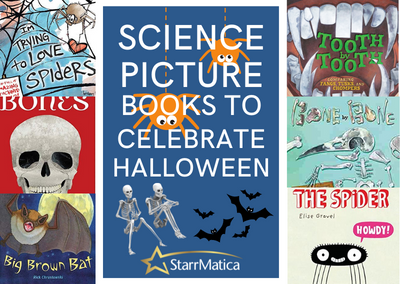The leaves are changing colors here in Iowa and pumpkin-spiced everything has exploded in town – seriously, in my house we have pumpkin scented hand soap! If you are anything like me as a teacher, I flipped the calendar to October and began looking for ways to sprinkle Halloween themes into my teaching to delight my students – and let’s face it – it is fun to let our spooky creative vibes flow!
The good news is that Halloween and science fit together like spiders and webs! I mean – learning about spiders, bats, and skeletons practically screams Halloween! (Imagine spooky haunted house scream here!) So, to save you a little time, I’ve put together a list of my favorite science picture books perfect for Halloween! Along with a description of each book, I’ve added a question to discuss that focuses on one of the crosscutting concepts that scientists use to understand and describe the world around us.
BATS
I don’t know about you, but I love it when my students can learn science concepts through fictional stories. There are several picture books I love that entertain and inform about bats:
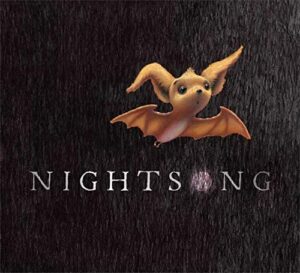 Nightsong by Ari Berk tells the story of little bat that takes his first solo flight into the night and learns to use his “song” to “see” the world around him in the dark.
Nightsong by Ari Berk tells the story of little bat that takes his first solo flight into the night and learns to use his “song” to “see” the world around him in the dark.
Here is a Patterns question to ask:
Why do bats need to understand sound patterns in order to “see” in the dark?
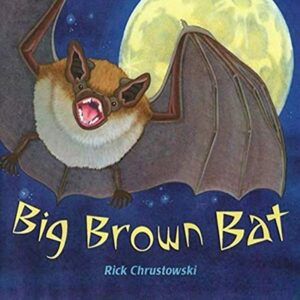 Big Brown Bat by Rick Chrustowski follows a newly born bat as it learns to fly, hunt, and get ready for hibernation.
Big Brown Bat by Rick Chrustowski follows a newly born bat as it learns to fly, hunt, and get ready for hibernation.
Here is a Patterns question to ask:
What patterns help you identify a bat as a different animal than a bird?
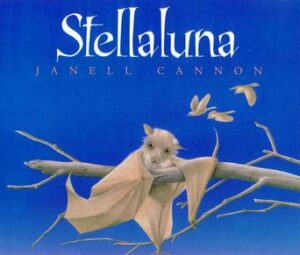 Stellaluna by Janell Cannon tells the story of a fruit bat who has been separated from her mother. Stellaluna has to survive with a family of birds, mimicking the behavior of this different species until she is reunited with her bat family again.
Stellaluna by Janell Cannon tells the story of a fruit bat who has been separated from her mother. Stellaluna has to survive with a family of birds, mimicking the behavior of this different species until she is reunited with her bat family again.
Here are some Structure and Function questions to ask:
What is Stellaluna able to do that the birds are not? What structures enable her to do those functions? What functions are both Stellaluna and the birds able to do? What structures allow them to do those functions? How are those structures similar? How are they different?
SPIDERS
I hope you love these books about spiders as much as my kids and I do. They are sure to make you laugh – or at least chuckle – while you learn about these creepy crawly critters:
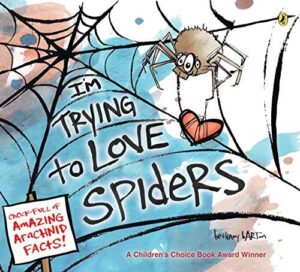 In I’m Trying to Love Spiders, Bethany Barton uses humorous illustrations and facts about spiders to try and convince readers – and herself! – that spiders should be loved rather than feared.
In I’m Trying to Love Spiders, Bethany Barton uses humorous illustrations and facts about spiders to try and convince readers – and herself! – that spiders should be loved rather than feared.
Here is a Structure and Function question to ask:
What structures does this organism use to meet its basic needs for survival?
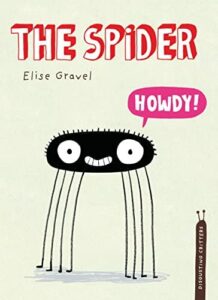 The Spider by Elisa Gravel is an entertaining text with illustrations that are sure to make you laugh out loud while learning facts about spiders. Here’s a great read aloud version: https://www.youtube.com/watch?v=IAM_zi0UcMU
The Spider by Elisa Gravel is an entertaining text with illustrations that are sure to make you laugh out loud while learning facts about spiders. Here’s a great read aloud version: https://www.youtube.com/watch?v=IAM_zi0UcMU
Here is a Structure and Function question to ask:
What can you infer about the structure of spider silk given all of the functions it can perform?
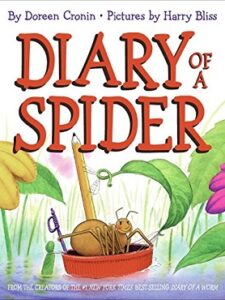 Diary of a Spider by Doreen Cronin is a more well-known choice that is written as a sequence of events in the life of a young spider.
Diary of a Spider by Doreen Cronin is a more well-known choice that is written as a sequence of events in the life of a young spider.
Here is a Systems and System Models question to ask:
What system are spiders part of? What are the parts of the system and how to they interact with one another?
SKELETONS
This section includes some of my favorite books for exploring Structure and Function. There are just so many relationships between the shape of a bone and its function that you can explore by comparing similar bones across different skeletons. My 5 year old is currently obsessed with the first two texts to the point at which I have parts of them memorized!
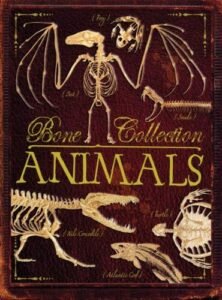 Bone Collection: Animals by Rob Colson functions as a fantastically illustrated bone encyclopedia for student research. An animal’s skeleton is presented for analysis along with information about how the animal lives and survives.
Bone Collection: Animals by Rob Colson functions as a fantastically illustrated bone encyclopedia for student research. An animal’s skeleton is presented for analysis along with information about how the animal lives and survives.
Here’s a Structure and Function prompt:
Choose a specific skeleton and explain how its structure enables the animal to have specific functions.
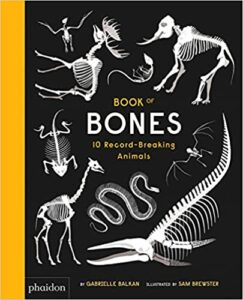 Book of Bones by Gabrielle Balkan challenges students to guess what animal’s skeleton is shown. The “raised” bones in the illustrations are a fun treat for students – especially those engaged by tactile experiences.
Book of Bones by Gabrielle Balkan challenges students to guess what animal’s skeleton is shown. The “raised” bones in the illustrations are a fun treat for students – especially those engaged by tactile experiences.
Here’s a Structure and Function prompt:
Choose a bone structure that is common among two or three of the animals. How is structure similar and different between the animals? How do the similarities and differences relate to the functions each animal can perform?
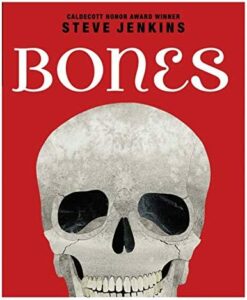 In Bones by Steve Jenkins, skeletons in the animal world are compared through detailed illustrations so readers can discover their striking similarities and differences.
In Bones by Steve Jenkins, skeletons in the animal world are compared through detailed illustrations so readers can discover their striking similarities and differences.
Here is a Patterns question to ask:
What patterns do you notice in the structures of bones?
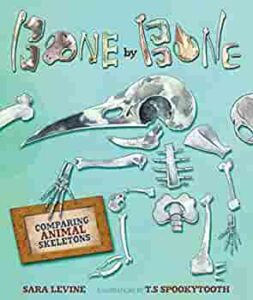 Bone By Bone by Sara Levine describes how different bone structures determine what animals look like and what they can do using humorous illustrations.
Bone By Bone by Sara Levine describes how different bone structures determine what animals look like and what they can do using humorous illustrations.
Here is a Systems and System Models question to ask:
Are the bones in your body a system? Why or why not?
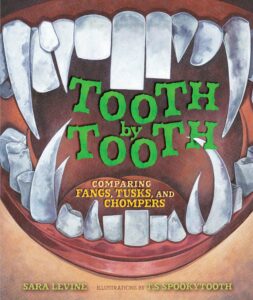 Tooth by Tooth by Sara Levine has comical illustrations that add to the engaging text that compares animal teeth to human teeth. The text focuses on how the structure of an animal’s teeth help it to perform specific functions.
Tooth by Tooth by Sara Levine has comical illustrations that add to the engaging text that compares animal teeth to human teeth. The text focuses on how the structure of an animal’s teeth help it to perform specific functions.
Here are Structure and Function questions to ask:
How do the structures of different animal teeth help them to perform different functions?
How does the structure of an animal’s teeth that is not included in the book help you to predict how the animal uses those teeth?
Looking for additional science texts? Check out StarrMatica Texts: Science Your Way, our library of K-5 science informational texts that can be customized to meet specific Common Core ELA standards. Each 1st – 5th grade text has multiple reading levels so all of your students can read the same content independently.
Not a subscriber? Click here for a free trial to access our entire library of texts.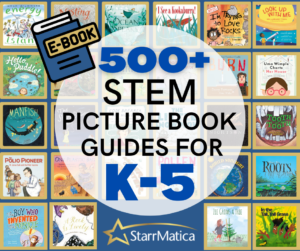
And if you are looking for additional picture books for your science classroom, check out the Perfect Picture Book Pairing Series that includes one-page guides with activities and discussion questions for hundreds of STEM-themed picture books aligned to every NGSS performance expectation!
CLICK HERE TO PREVIEW THE PERFECT PICTURE BOOK PAIRING EBOOKS

